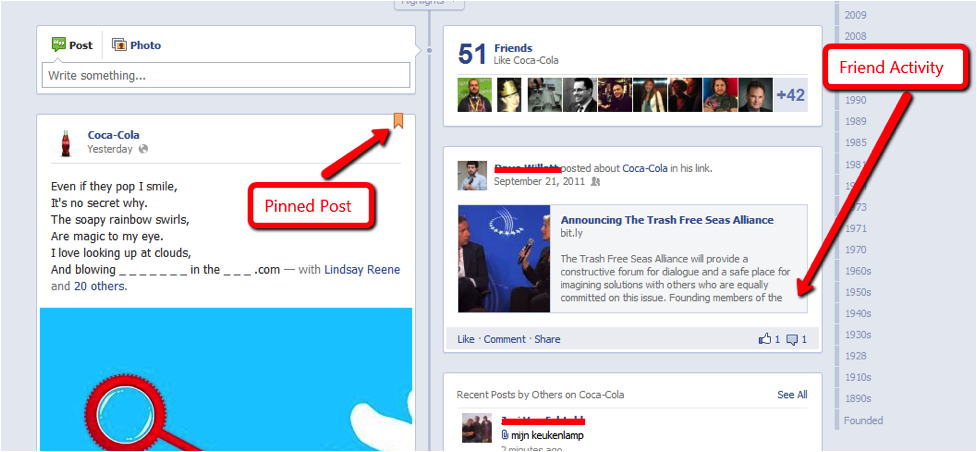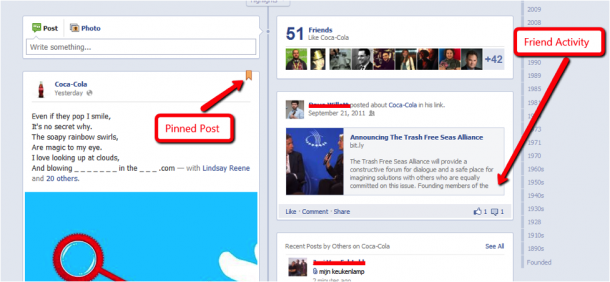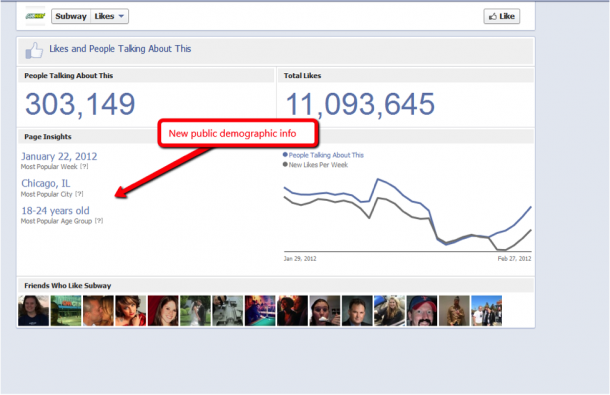Facebook unveiled timeline for pages this week, along with a number of equally important product and platform upgrades. While I’m sure there will be posts picking apart each and every one of these changes, I am going to focus primarily on the Timeline for Pages changes.
Here are FIVE key things you need to know about the new brand page format:
1. The Timeline
The timeline for pages serves the same purpose it does for personal profiles – it tells your story. How little or much you wish to share is up to you but it’s important to remember to think about what your friends or fans would be interested in seeing. For example, content that is emotive tends to do well so leveraging key milestones and dates of yours and your community will do well, even more so as you consider creative ways to turn these events into bigger stories.
Your friends’ activities and interactions with a page now populate a brand’s timeline. A more relevant and personal experience can be delivered for each user by being able to see how their friends are engaging.
There is a heavy emphasis on visual story telling as photo albums appear more prominently in the timeline and select images or posts can be “starred and expand across the entire width of the timeline.
2. Cover and Profile Images
The cover image is obviously the first thing your fans will see. However, Facebook has been pretty specific about the fact that it can NOT be used for promotions, call to actions, or advertising. That means no arrows pointing to custom tabs or like buttons, no coupon info, text-only messages…nothing. This should be kept in mind as you create your engagement strategy. The ability to “pin posts (more on that later) will work as an alternative to draw attention to specific pieces of content on your page.
Important to note is that dimensions on the page have changed so you need to be aware of how both your profile photo and your cover image appear on the new timeline. The new dimensions are:
- Cover Image: 851 x 315 px
- Profile pic: 180 x 180 px
3. Bye Bye Default Landing Tabs
One of more popular tactics in the past few years were customized landing tabs. These were used in many ways but are most commonly associated with ‘Welcome’ pages to drive new Likes and give news users a “controlled first experience.
Yeah, well that’s not happening anymore as there are no landing pages; you cannot set a default landing tab. Instead you can reposition tabs at the top of the timeline to highlight the ones you want your followers to engage with and then use regular content updates to draw attention to those tabs. The only way you can create a default landing tab type of campaign is to associate a paid advertisement with the custom tab as the URL.
4. The Pin is IN
Ok, so I know you’re probably over Pinterest and the pinning craze by now but this pun actual holds value on the new timeline for pages. You can now pin a post so it appears as the first post people see for seven days. After that, it will be pushed down the timeline as other content is added.
Why is this important?
A few reasons. First of all, it means you have the opportunity to highlight select pieces of content for a week and set it up as the first thing people see on your page (more on why this is important later). This allows you to be better equipped to run weekly content campaigns as you can highlight your core content.
Another reason this is important is because it will change the way you set up your editorial calendar. While some manage their content by the seat of their pants, this forces you to think about what items for the week you really want to highlight as the main content posts and what pieces become supplemental items. It will help tremendously with creating weekly messaging campaigns for brands. Pinning an item at the top of your feed might be important to you if you want to draw attention to a tab that normally you would’ve had as a default landing page.
Here’s a screenshot of Coca-Cola’s timeline with both Friend Activity (mentioned earlier) and Pinned Posts highlighted:
5. It’s About Engagement, Stupid
Several changes to the admin panel support the notion that success on Facebook will be brought on by creating engaging, smart content rather than simply classic advertising campaigns. Fans of pages can now interact with the page through private messages. Though you can no longer restrict your wall view to show only posts from the page, you can now manually approve every post from fans before they are published.
If you click the “likes tab on any brand timeline page, you’ll see more public analytics than before:
The demographic info and ability to see when pages you don’t manage were most popular allows you to get more of a sense of what your competitors are doing from the engagement standpoint. This will help with targeting and force brands to compete more as they are aware when each other’s peaks and successes are occurring. Additionally, it continues the trend of de-emphasizing total “like count as a means of judging success of a page by encouraging marketers to focus on creating engaging content, not just numbers.
Conclusion
There are still a number of other new changes that are being rolled out on the Facebook platform, but the overall takeaway is that your brand or organization needs to commit to storytelling of past, present, and future as the most effective way to see success on Facebook.
Could this all change a few months down the road (especially when Facebook goes public)? Sure. But generally speaking, visually compelling content and effective story-telling will always win out over static broadcasting.
Though you have until March 30 to experiment with your new timeline features, several brands have already jumped out and launched their pages.
Adam Rosenberg is an account supervisor at Edelman Digital in San Francisco and has developed social media strategies for a variety of political and advocacy campaigns, nonprofit groups, and many corporate brands. Additionally, Adam is co-owner and Chief Marketing Officer for Red Stapler Records, an avid surfer and Tough Mudder veteran, and a musician and DJ (under the name DJ Phillyberg). The opinions in his contributions to this site are his alone and not those of his employer.




0 Comments